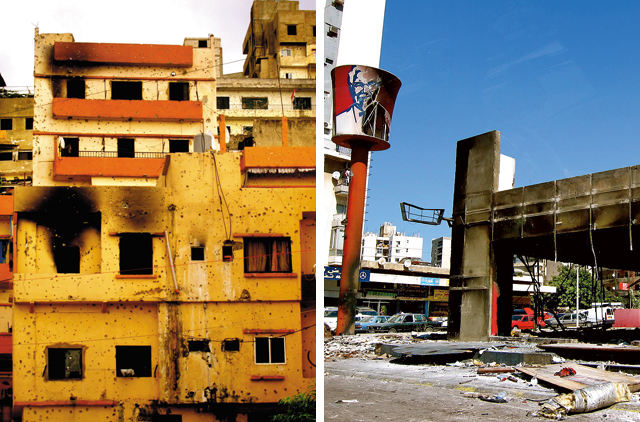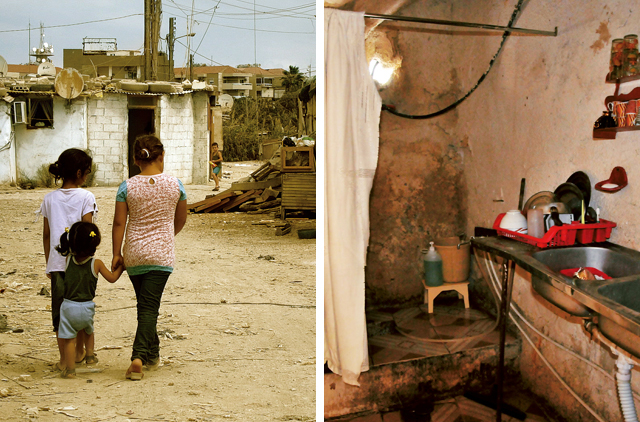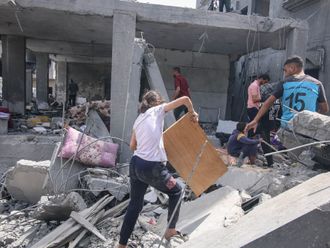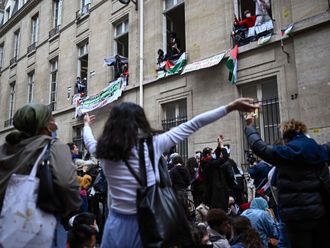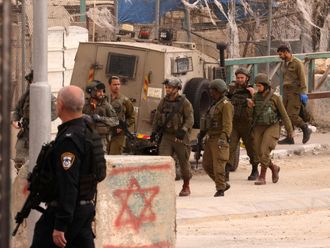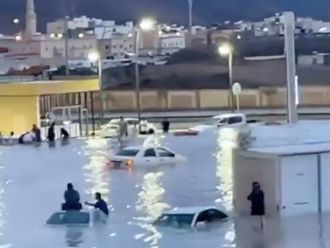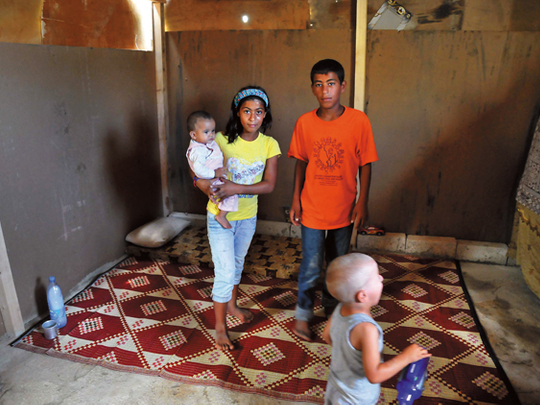
As the plane taxied at Beirut International Airport, the peripheral twinkling lights almost seemed pretty, nighttime innocently blanketing Burj Al Barajneh.
Darkness can easily deceive the oblivious traveller, possessing the power to mask reality. For those who have seen dawn lay bare the realities of the 60-year-old district, pretty is not a word you would associate the place with.
In 1948 the area was set aside for fleeing Palestinians and today 16,000 refugees still reside there, a drop in the ocean compared to the 400,000 other Palestinians that live across Lebanon.
Looking out of the plane window that evening I wondered what the future would hold for the Syrian refugees now flooding into the country, escaping an 18-month-old civil war.
In many respects, time has stood still in Lebanon and the country is consequently ill prepared to accommodate another influx of refugees. The Lebanese government has attempted to make itself comfortable with a back-seat role this time, leaving assistance in the hands of non-governmental organisations.
If aid agencies are hard pressed to assist Syrian refugees in Jordan and Turkey – both supported by their governments – then the situation in Lebanon could be predestined.
Tripoli – A tale of two cities
The journey from war-ravaged Syria into Lebanon is not an easy one. En-route, refugees face shelling, gunfire, snipers, militias and landmines, and once over the border, they encounter the arduous task of locating food, shelter and medical assistance.
Despite efforts by the UNHCR (United Nations High Commission for Refugees) to register all of the displaced, exactly how many have crossed into the country is still unclear. The latest figures suggest 77,000 but analysts believe that figure is far higher.
Reaction to the crisis has been mixed in Lebanon and the government, torn between those that support President Bashar Al Assad and those who sympathise with the revolution, has denied the right to create a refugee camp, something the UNHCR supports.
“For us, camps are a last resort… In Lebanon refugees are living in small communities… this type of environment allows for ‘normal’ living conditions,” says Ninette Kelly, UNHCR’s representative in Lebanon.
But with no focal point in which to gather, the majority of the displaced people gravitate towards areas that share their political and religious beliefs. As a predominantly Sunni region, much like the Syrian opposition, the northern city of Tripoli has been overwhelmed with refugees.
Although a UNHCR registration centre has existed in the city since August, many of the displaced have failed to register for fear of retribution from a government they associate with the Al Assad regime.
Instead, they turn to small Islamic charities and grassroot NGOs. Consequently, Tripoli has come to be seen by many as not only a haven for Syrian refugees, but as intrinsically linked with the revolution next door.
Tripoli is the poorest city on the Mediterranean coast and often conjures up images of terrorism, protests and unrest; even to a local Lebanese, a visit warrants the words “take care”.
Limitless media reports recount tales of violent mobs, fatal clashes and warring neighbourhoods. Sadly the media is not wrong, these events occur frequently in the city battling chronic unemployment and a
stagnant economy.
But every story has two sides and Tripoli is no different. Scratching beneath the surface an undeniably altruistic Tripoli is revealed. A city filled with charitable organisations working to provide for those less fortunate.
In the words of Nasr Maamari, managing director of Dar Al Zahraa Hospital and Orphanage, “In Tripoli, it’s the poor helping the poorer.” Dar Al Zahraa sits in the Zaytoun Abu Samra district and 50 of its 74 beds are allocated to injured Syrians. The number of refugees here varies daily depending on the ferocity of fighting between Al Assad’s forces and the Free Syrian Army (FSA).
During the March massacre in Homs, which saw a brutal attack on the already besieged city, including the stabbing of 47 women and children to death, the hospital was pushed well over capacity. Rooms normally occupied by two were crammed with the injured, corridors were crowded with the wounded and public appeals were made for urgent assistance.
“Ambulances were coming every hour transporting the injured,” says one volunteer. “Some of them were in critical condition, many had been operated upon just hours before. There were people without arms, others without legs, most were hysterical. There were so many volunteers, but the injured just kept on arriving, we had to go next door to wake up the orphans so we could take their beds.”
Grim tales to tell
For now things are calmer in Dar Al Zahraa, but no less tragic. The corridors may no longer be filled with the dying but there is an overpowering and immediate sense of loss. The air is heavy with a mixture of stale cigarette smoke and detergent, the sound of fans endlessly humming. There is no air conditioning and in each room makeshift curtains billow in the stifling breeze. Every room shelters those with horrors to tell.
One amputee, who crossed the border seeking protection for his family, was hit by a shell on Lebanese soil. He sobbed as he recounted the explosion. “My daughters were playing outside when I heard shooting coming from the Syrian side of the border. I ran outside to save them but then everything went black.
“When I woke up, I was in a hospital. I stayed there for a month with no information about my family, no one wanted to tell me the truth that my seven and ten-year-old little girls had both died. I have lost both my arms and a leg, and the bomb was so loud my eardrum burst. I’m deaf in one ear. I just can’t believe this has happened to me.”
Dar Al Zahraa is looking to provide those who have lost limbs with prosthetic arms but the price is high and funding is low. The average price tag for a prosthetic right arm is $16,000 (Dh58,771) and amputees from Syria are frighteningly common. The hospital desperately needs funding; the orphanage receives 90 per cent of its finance from the government for Lebanese children, but money for Syrians must come from elsewhere.
The London-based Syrian National Council pays a special rate of $20 a day per bed, which includes food, medical aid and physiotherapy, while in return for providing them with a free clinic, Dar Al Zahraa now also has the assistance of Médecins Sans Frontières.
Although it plays an important humanitarian role in the refugee crisis, the hospital functions in a country that is deeply divided over how best to deal with its neighbour’s war.
The Western-backed opposition supports the uprising while Hezbollah strongly supports Bashar Al Assad. Repercussions of this division have been felt at the hospital, which has been subjected to hostile media reports including accusations of organ trafficking.
Despite the threats to his family’s hospital Nasr says, “Here there are no questions asked, the injured are welcome whether they are FSA or not. We are carrying out a humanitarian role, we have children, we have women and we are simply trying to help. We put our heads down, ignore the media and do our job.”
Seeking shelter
However, the hospital cannot offer a long-term shelter solution for the wounded, and although some stay to work as volunteers, the majority must seek housing elsewhere. The Syrian National Council is currently setting up an organisation to help the homeless, but a monumental task lies ahead.
When asked what challenge is the most pressing for refugees in Lebanon, the UNHCR says “shelter”, a sentiment echoed by all of those addressing refugees’ needs. On the ground in Tripoli one organisation, Bayt Al Zakat, is working around the clock to find adequate shelter for the displaced.
Currently a large number of refugees live in the city’s deserted buildings, sleep on the streets, find wasteland on which to build makeshift huts or are forced to pay inflated rent for dilapidated apartments.
One family pays $200 a month for the ‘luxury’ of one room with an adjoining kitchen and bathroom. The mother of the family, Halijeh, says, “We were forced to leave our home because the killing got so bad in Homs. They started kidnapping and killing children and we were worried ours would be taken. Here we have to wash, use the toilet and cook in the same room. We have had to put rags to block the holes because snakes come in at night. Last week I went back to Homs, to check our house. There is nothing there, just rubble. It’s gone.”
A makeshift home, a makeshift life
In the Al Mina district along the coast, an area of wasteland has been turned into a shanty town. Heaps of debris litter the land, car parts are strewn next to a makeshift playground, burnt-out oil drums lie on their side in the midday sun where nearby, children play with castaway toys.
The houses are patched together with an array of materials: old doors, discarded planks of wood, roofs made of corrugated iron or, for those less fortunate, plastic sheeting. Outside one of these homes, a woman hangs clothes on a line between two weeping trees.
There are obvious attempts to make this home. Flowering plants have been potted in empty baby milk tins. Inside, the room is spotless in stark contrast to the mounds of rubbish outside. A carpet covers the floor and mattresses are neatly tucked in the corner. There’s a picture on the wall of a young girl smiling, a reminder of happier times.
Despite her poverty, the woman, Fatima, offers coffee. “My husband is a fighter for the FSA,” she says. “He forced me and the children to leave. We had to walk for three days while they shelled, fearing we would be shot. We had problems when we first got here with the Lebanese International Security Forces because these houses aren’t allowed, but we managed and they have left us alone for now. Next I need to get the kids back to school, but the bus alone costs $70 a month. I can’t afford that. The UNHCR is looking to help me.”
The problems facing the refugees are innumerable. Those that are fortunate enough to secure shelter often struggle day by day to find food or medicine. Just a few kilometres from Al Mina, Syrian refugee families occupy a deserted hospital. The landlord has allowed them to live in the building rent free, but insists they contribute nominally for maintenance.
‘We have babies we can’t feed’
Rooms on all five floors house more than three families each. One room, smaller than the average villa bathroom, is home for a family of seven. The matriarch despairs at their future. “We only have one other man here to provide for seven of us, all the others are dead or stayed in Syria to fight. He works seven days a week for $60 a month. We have babies we can’t feed, my daughter is pregnant, and we desperately need nappies and milk. Look at the children, they are becoming so thin.”
Charities are working hard to overcome the challenges of a scattered refugee community, but without the commitment of the Lebanese government, providing humanitarian relief is proving to be more than testing.
Lebanon is not a signatory of the UNHCR 1951 Refugee Convention and is not legally obliged to help. However, the conflict in Syria shows no sign of waning. Ultimately the displaced will continue to flee bullets, bombs and torture.
Former Member of Parliament Mosbah Ahdab summarised the situation well when he said, “The social fabric between Lebanese and Syrians has done much more than the government. It doesn’t want to accept reality. The government should recognise the real problem and the real numbers… We should give full protection to the Syrian refugees present here in Lebanon.”


